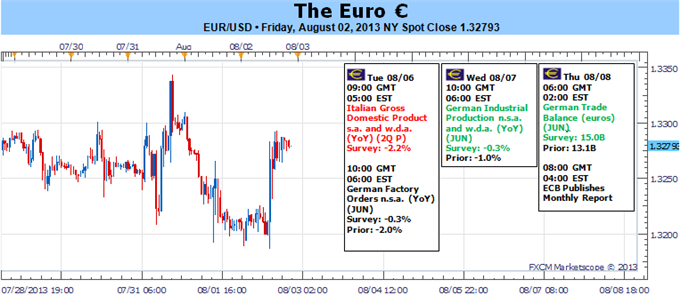
Euro Targets 1.3250 but Difficult with Risk Trends, Italian GDP
Fundamental Forecast for Euro: Neutral
ECB holds its course on monetary policy without further clarity from guidance
Spain remains mired in recession but there is light at the end of the tunnel
EURUSD retreats from test of trendline resistance that defines 2013
The euro managed to gain ground against all but one of its major counterparts this past week: the US Dollar. EURUSD is the FX market’s benchmark pair, and its congestion is telling of the conditions for the underlying market. Yet, given the absence of overriding themes like ‘risk trends’ and speculation surrounding the Federal Reserve’s stimulus withdrawal (the Taper), euro-based fundamentals can carry more influence. That will be particularly interesting for pairs like EURUSD or EURJPY prone to breakouts as top tier event risk like the Italian 2Q GDP release cross the wires.
Over the past few weeks, the periphery members of the Eurozone were in focus as potential catalysts for euro-based volatility. The IMF and European Union approving Greece’s latest tranche of aid, Portugal avoiding an early election and thereby deviation from its austerity course, and Cyprus receiving the ‘okay’ from its Due Diligence assessment averted the revival of systemic crisis concerns. Of course, over the past months, there have been a number of events that have not fallen in favor of progress or even status quo. And despite the negative implications, the euro has held steadfast. This may suggest that investor confidence has built up an immunity to regional problems that are not critical.
As the market plays down temporary troubles on the long road to recovery for countries like Greece and Portugal, though, it is important to remember that tremors in the Eurozone’s foundation can add a new element to the region’s stability – not to mention greater short-term volatility. In the coming week, headline event risk comes from the initial (preliminary) reading of 2Q Italian GDP. The Union’s third largest economy has contracted for seven consecutive quarters, and the most recent reading is expected to print another 0.4 percent contraction. A slog is priced in, so meeting expectations is unlikely to generate waves – this past week, Spain reported an extension of its own recession with a 0.1 percent drop for the quarter, and the euro hardly blinked. Yet, in these conditions, even a hearty disappointment may struggle to upgrade a sharp, short-term move to a lasting bear trend.
If a core member’s growth report struggles to muster a heavy reaction from the world’s second largest currency, ‘regular’ event risk will have to try even harder to leverage a meaningful move from the euro. Notable releases to keep an eye on includes the regional service sector activity indicator, German trade, the Sentix Eurozone investor confidence survey, the ECB monthly report and Greek unemployment rate (more at the Economic Docket). With a significant enough ‘surprise’, these updates can generate volatility. However, we shouldn’t expect trends from these headlines unless there is a more convincing theme at play and the releases complements an existing lean.
One consideration for amplifying a fundamental jolt into a bigger market move is to see the docket listing capitalize on proximate technical levels. A great example to start the week is EURUSD’s range between 1.3300 (hemmed by a trendline originating with the May 2011 swing high) and 1.3175 (a collection of technical measures). That is a narrow walkway should winds pick up, and a spike in volatility can ultimately trip a wave of speculative positioning further than data or a news item could alone. Should we be trading on the cusp of this range heading into the Italian growth report, it could pose a serious breakout risk.
Though the threshold for a substantive trend for the euro has been set higher and the scheduled event risk is considered to hold limited influence, there are still sources of turbulence that can return EURUSD to greater extremes like 1.3500 and 1.3000 or send EURJPY above 134 or below 130. To manage such an upgrade in conviction, we would need to tap a deeper well of concern or appetite. A wholesale wave of risk aversion represents an ever-present threat as it can quickly redefine manageable troubles into crises. Alternatively, the same extreme for optimism will be difficult to muster given the rich pricing of low yield / high risk assets. A material return to Eurozone crisis is another lingering possibility. Given the constant probes to market confidence, it would likely have to be a severe deterioration in one of the known issues (Greece heading for the exit) or some as yet unknown and thereby unpriced risk. –JK
Follow me on twitter at http://www.twitter.com/JohnKicklighter
Sign up for John’s email distribution list, here.
DailyFX provides forex news and technical analysis on the trends that influence the global currency markets.Learn forex trading with a free practice account and trading charts from FXCM.
Source: Daily fx
